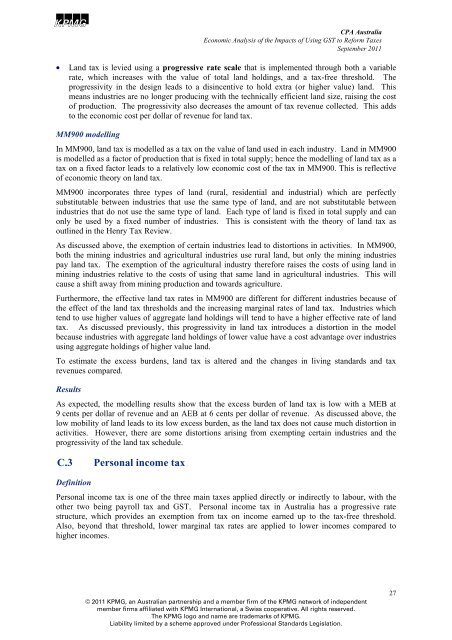kpmg-econtech-final
kpmg-econtech-final
kpmg-econtech-final
- No tags were found...
You also want an ePaper? Increase the reach of your titles
YUMPU automatically turns print PDFs into web optimized ePapers that Google loves.
ABCDCPA AustraliaEconomic Analysis of the Impacts of Using GST to Reform TaxesSeptember 2011• Land tax is levied using a progressive rate scale that is implemented through both a variablerate, which increases with the value of total land holdings, and a tax-free threshold. Theprogressivity in the design leads to a disincentive to hold extra (or higher value) land. Thismeans industries are no longer producing with the technically efficient land size, raising the costof production. The progressivity also decreases the amount of tax revenue collected. This addsto the economic cost per dollar of revenue for land tax.MM900 modellingIn MM900, land tax is modelled as a tax on the value of land used in each industry. Land in MM900is modelled as a factor of production that is fixed in total supply; hence the modelling of land tax as atax on a fixed factor leads to a relatively low economic cost of the tax in MM900. This is reflectiveof economic theory on land tax.MM900 incorporates three types of land (rural, residential and industrial) which are perfectlysubstitutable between industries that use the same type of land, and are not substitutable betweenindustries that do not use the same type of land. Each type of land is fixed in total supply and canonly be used by a fixed number of industries. This is consistent with the theory of land tax asoutlined in the Henry Tax Review.As discussed above, the exemption of certain industries lead to distortions in activities. In MM900,both the mining industries and agricultural industries use rural land, but only the mining industriespay land tax. The exemption of the agricultural industry therefore raises the costs of using land inmining industries relative to the costs of using that same land in agricultural industries. This willcause a shift away from mining production and towards agriculture.Furthermore, the effective land tax rates in MM900 are different for different industries because ofthe effect of the land tax thresholds and the increasing marginal rates of land tax. Industries whichtend to use higher values of aggregate land holdings will tend to have a higher effective rate of landtax. As discussed previously, this progressivity in land tax introduces a distortion in the modelbecause industries with aggregate land holdings of lower value have a cost advantage over industriesusing aggregate holdings of higher value land.To estimate the excess burdens, land tax is altered and the changes in living standards and taxrevenues compared.ResultsAs expected, the modelling results show that the excess burden of land tax is low with a MEB at9 cents per dollar of revenue and an AEB at 6 cents per dollar of revenue. As discussed above, thelow mobility of land leads to its low excess burden, as the land tax does not cause much distortion inactivities. However, there are some distortions arising from exempting certain industries and theprogressivity of the land tax schedule.C.3 Personal income taxDefinitionPersonal income tax is one of the three main taxes applied directly or indirectly to labour, with theother two being payroll tax and GST. Personal income tax in Australia has a progressive ratestructure, which provides an exemption from tax on income earned up to the tax-free threshold.Also, beyond that threshold, lower marginal tax rates are applied to lower incomes compared tohigher incomes.© 2011 KPMG, an Australian partnership and a member firm of the KPMG network of independentmember firms affiliated with KPMG International, a Swiss cooperative. All rights reserved.The KPMG logo and name are trademarks of KPMG.Liability limited by a scheme approved under Professional Standards Legislation.27



